Family : Muraenidae

Text © Giuseppe Mazza

English translation by Mario Beltramini
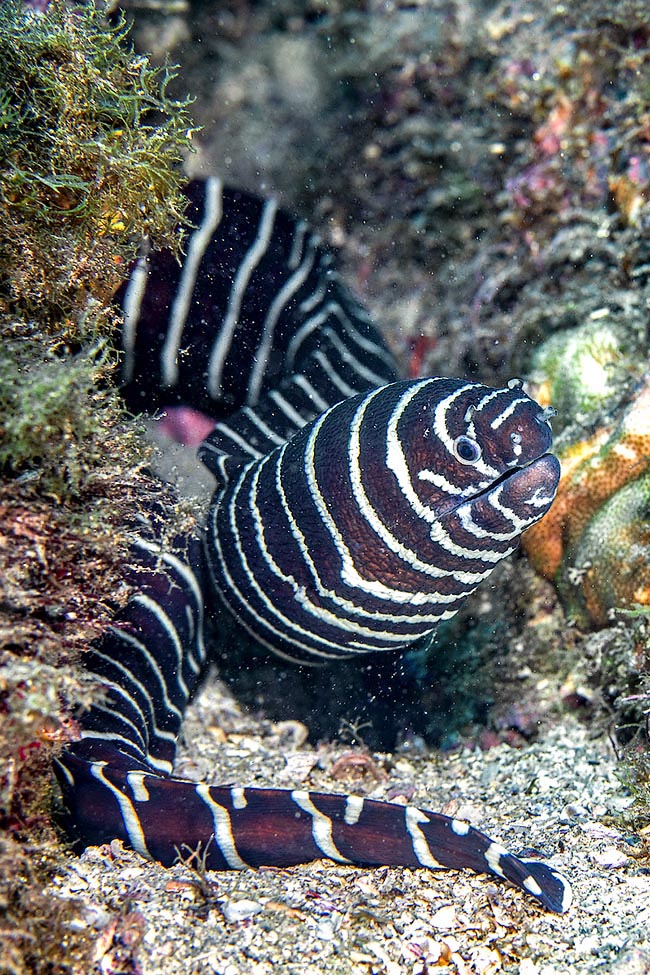
Gymnomuraena zebra has a very vast range in the Indo-Pacific, from Red Sea and South Africa to Central America © Allison & Carlos Estape
The Zebra moray, Gymnomuraena zebra (Shaw, 1797), belongs to the class of the Actinopterygii, the ray-finned fishes, to the vast order of the Anguilliformes that counts 16 families, including the Muraenidae boasting more than 200 species.
The name of genus Gymnomuraena originates from the Greek “gymnos”, naked, and from the Latin “muraena”, name given by the Romans to the morays.
It is, therefore, a naked moray.
An etymology that evokes that of the genus Gymnothorax that talks of a naked thorax with reference, as probably also here, to the fact that unlike the eels the morays do not have pectoral fins, present only at the larval stage.
The specific term zebra, without any doubt, is a clear reference to the livery with dark and whitish stripes like those of the zebras.
Zoogeography
Gymnomuraena zebra has a very vast distribution in the tropical waters of the Indo-Pacific.
Just to give an idea, we find it from South Africa and Madagascar up to the Red Sea and the Arabian Sea, the Seychelles Islands, the Maldives, in India, in Sri Lanka, the Andaman Islands, Indonesia, Australia, New Guinea.
Northwards, in the Pacific, it has colonized the Philippine islands, Taiwan, and the southern part of Japan.
Southwards, it stops at the Australian Great Barrier Reef, but eastwards, after the Galapagos islands and the Hawaii, even reaches the American continent.
In fact, we find it on the western coast of Mexico, in Guatemala, Nicaragua, Costa Rica, Panama, Colombia, Ecuador and Peru.
Ecology-Habitat
The Zebra moray lives hidden among the madrepores, in shallow waters, but also on the outer side of the reefs, up to 50 m of depth.
Morphophysiology
Entirely harmless for humans, it reaches a maximum of 150 cm.
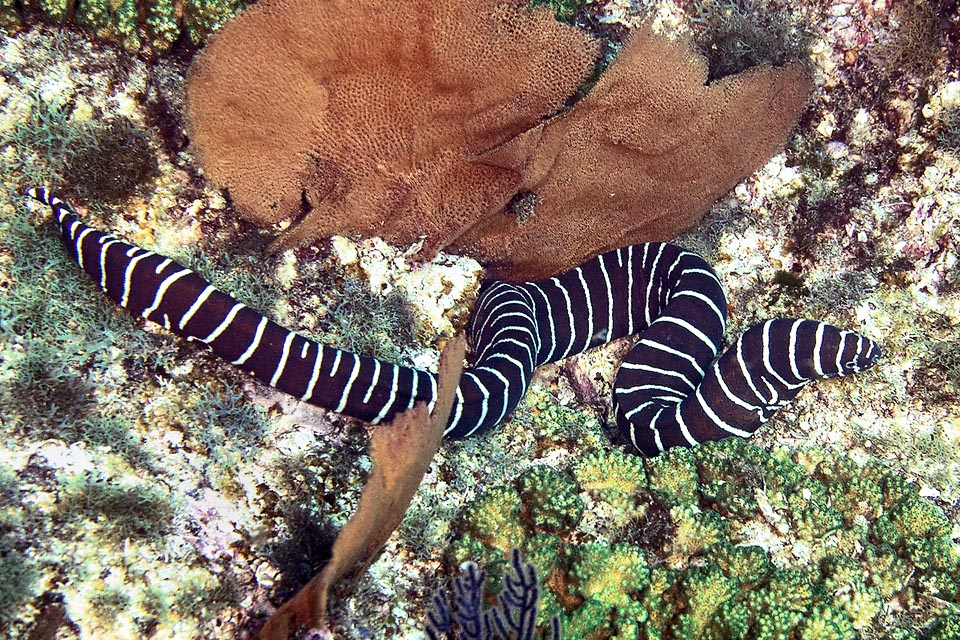
Even if the normal size is of about 50 cm, it can reach 150 cm and count even more than 100 clear rings, partly open © Allison & Carlos Estape
The dorsal, caudal and anal fins have merged to form only one long cutaneous crest on the back that then goes on after the tail up to the anus. It does not protrude much from the body and is not remarked at first sight like in other morays, because this single large fin, is hidden by the thick and fleshy skin.
Also here the pectoral and ventral fins are absent.
The serpentiform body, scaleless, is protected by a slippery mucus that allows these fishes to enter the ravines without getting hurt.
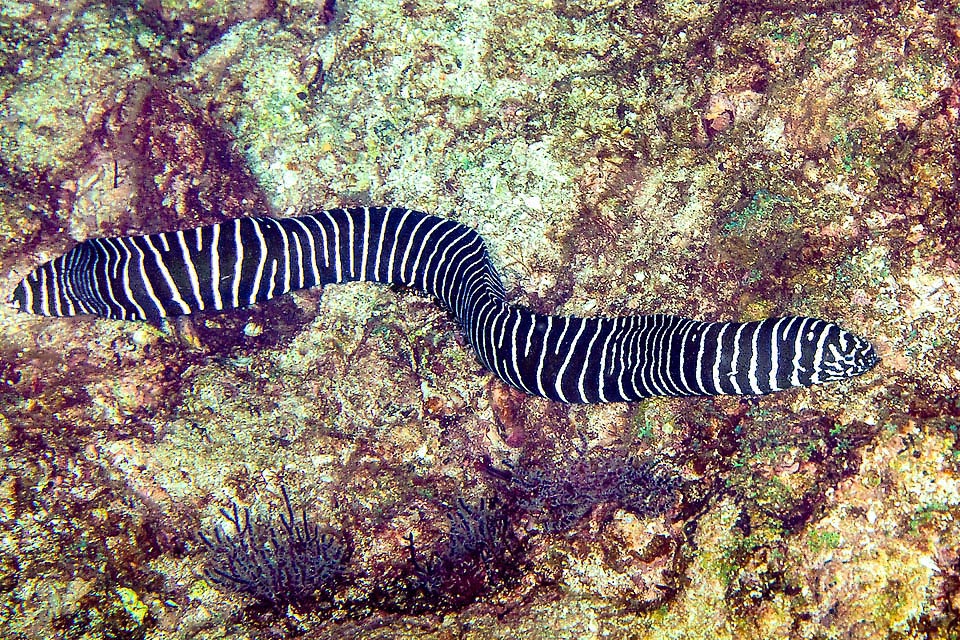
Has no scales, replaced by protective mucus. There are no pectoral and pelvic fins. The dorsal has merged with the caudal and anal fins for a serpentiform swimming © Allison & Carlos Estape
In place of the opercula they have two simple holes placed at the end of the head on the extension of the mouth.
Through these, differently than usual, it does not enter the water for oxygenating the gills, but gets out. In fact, the morays take it from the mouth that they open and close continuously for breathing.
The eyesight of the Zebra moray is not the best, but the sense of smell is very developed, with four tube-shaped nostrils.
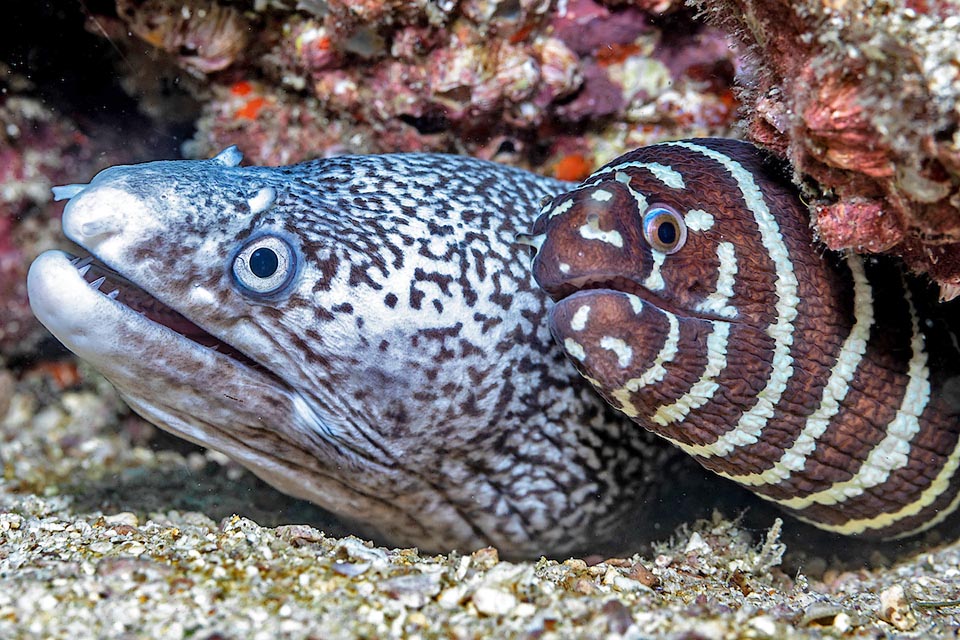
Gymnomuraena zebra rests during the day in a den that sometimes shares peacefully even with morays belonging to other species, like here with Muraena clepsydra © Allison & Carlos Estape
The first two, at the extremity of the snout, point downwards and the other two, placed high on the head at eye level, look on the sides to locate accurately, through the smell, where the preys are staying.
As a matter of fact, this is a fish living on the seabeds nourishing in the dark of small benthic preys that, feeling to be safe, mostly come out into the open during the night hours when most predators are asleep and therefore are not patrolling.
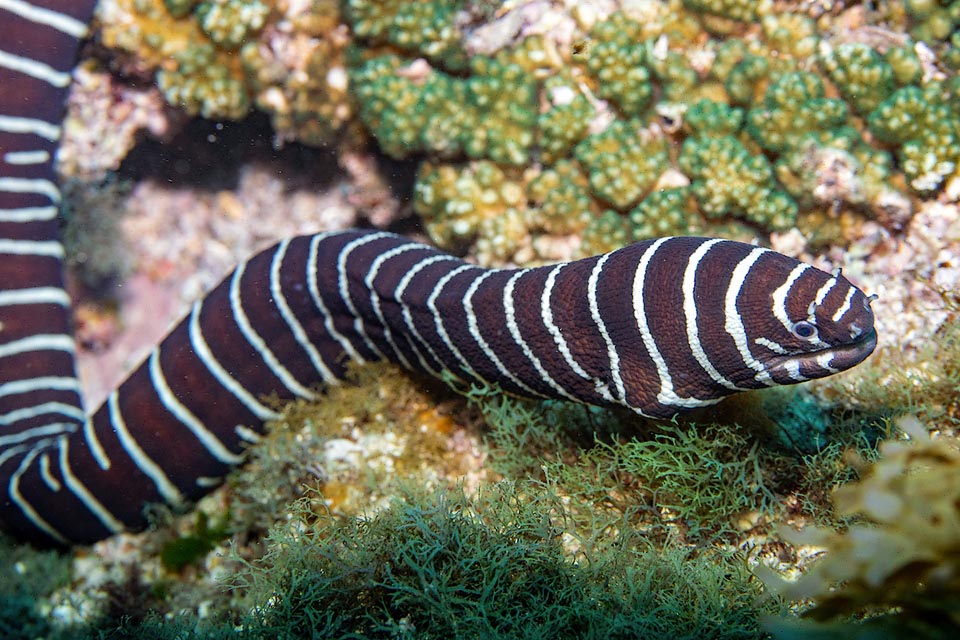
It hunts by night, when crabs, gastropods and sea urchins leave their shelters because there are less predators around © Allison & Carlos Estape
The snout of Gymnomuraena zebra is rounded and short. Seen from the front with its big gums may lead to thinking of an old lady without dentures.
When sleeping it opens and shuts the mouth, in fact, it looks at first sight of being toothless. In fact we do not notice on display the usual canines or hooked teeth for seizing and holding the preys, but looking carefully, when the jaws are wide open, appears a sort of cobble done by many small close together molars.
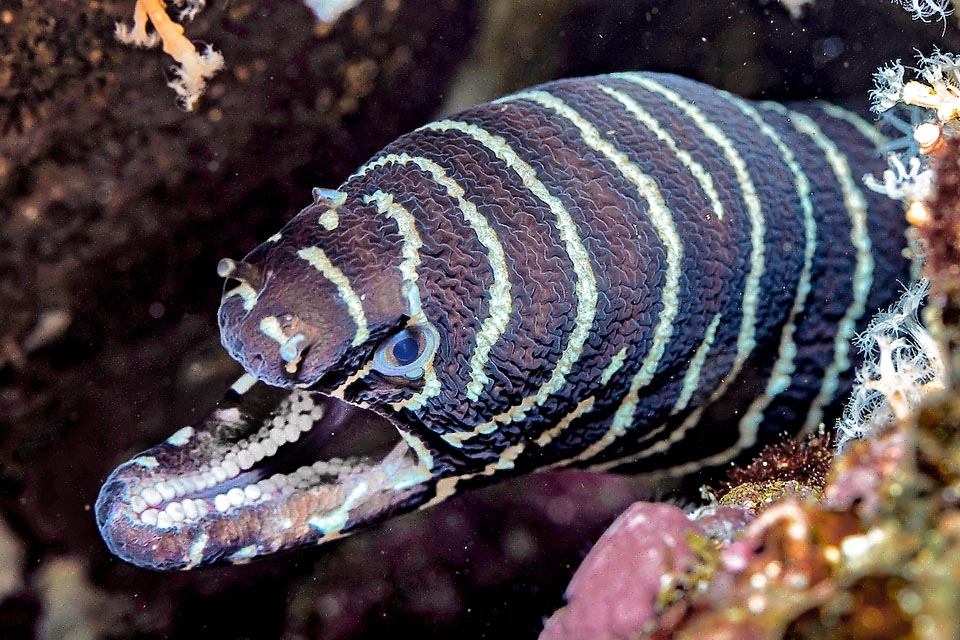
No sharp canines, as their preys do not go away, but rows of molariform teeth, present also on the palate, to crush like a nutcracker shells and carapaces © Allison & Carlos Estape
They are arranged in more rows: 2 or 3 on the sides of the lower jaw and 5 or 6 on the palate. A sort of nutcracker done for crushing the shells of animals that can’t run away and shred what is edible.
The livery has a reddish chocolate coloured where more than 100 creamy white coloured vertical bands stand out. They mainly form complete rings, but in 30-40% of cases they look broken for a better mimetic effect.
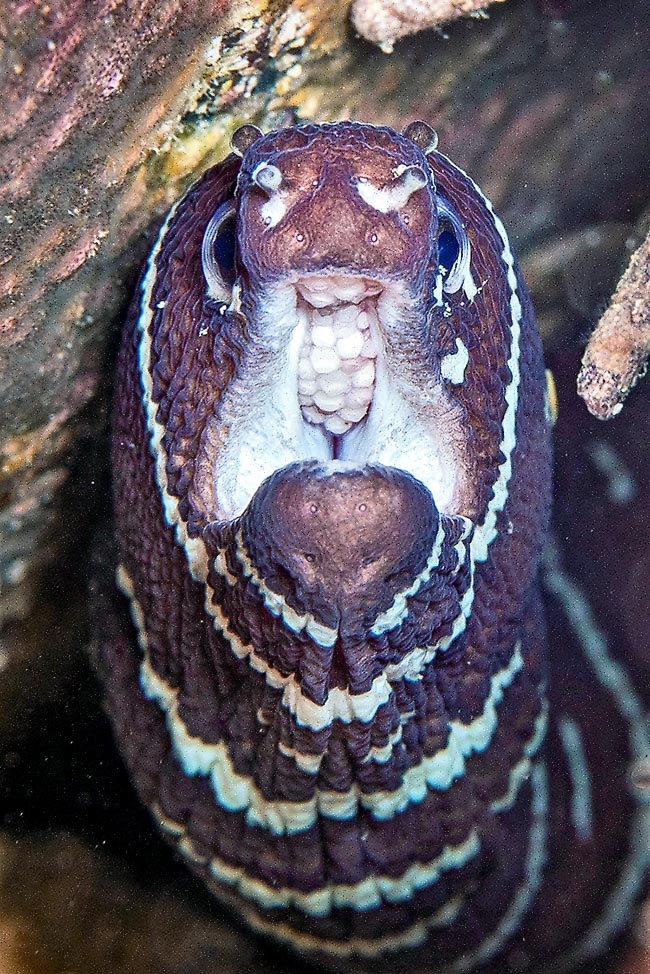
They look for crabs of the genus Etisus, with pulpy claws and sea urchins like Echinometra mathaei full of tasty eggs © Allison & Carlos Estape
Ethology-Reproductive Biology
Gymnomuraena zebra can live solitary but quite often shares the den peacefully with the conspecifics or other morays of modest size such as Echidna nocturna or Muraena clepsydra.
As soon as it gets dark, it leaves its shelter and goes around looking for mollusks and crustaceans to crunch, with a predilection for the crabs that have claws rich in pulp belonging to the genus Etisus, not to forget the accessible sea urchins, not too spiny and full in eggs, like Echinometra mathaei.
It seems, but it’s still to be proven, that it is a proterogynous hermaphrodite species, that is, with females who may turn into males starting from a certain size.
Not much is known about the reproductive modalities even if for the deposition partners have been seen swimming on the surface hugged.
What is sure is that the eggs are pelagic and that like all Anguilliformes the larvae, called while growing leptocephali, are transparent and flat, shaped like a willow leaf, with very small head.
This is a character evoking primitiveness in the world of fishes, typical to the superorder Elopomorpha born in the Cretaceous more than 140 million years ago.
In this phase of their life they have no red blood cells and therefore they are completely transparent, apart the voracious mandibles of the head with which they do not catch zooplankton, like the other larvae of the fishes, but seize the tiny food particles carried by the currents.
They may move forward or backward with rapid undulating movements or even wrap around themselves in a ring taking on the appearance of a small wandering cylinder that renders them similar to a little preyed on gelatinous zooplankton like the jellyfishes.
In suitable aquaria the Zebra moray is a calm and not very aggressive species that can live a long time but holds the record for escapes: if the cover is not closed well it can escape at night and can be found dead on the floor the next morning.
The resilience of this species is very low, if we consider that at least 14 years are needed for doubling the populations, and the fishing vulnerability, very high, marks even 90 on a scale of 100.
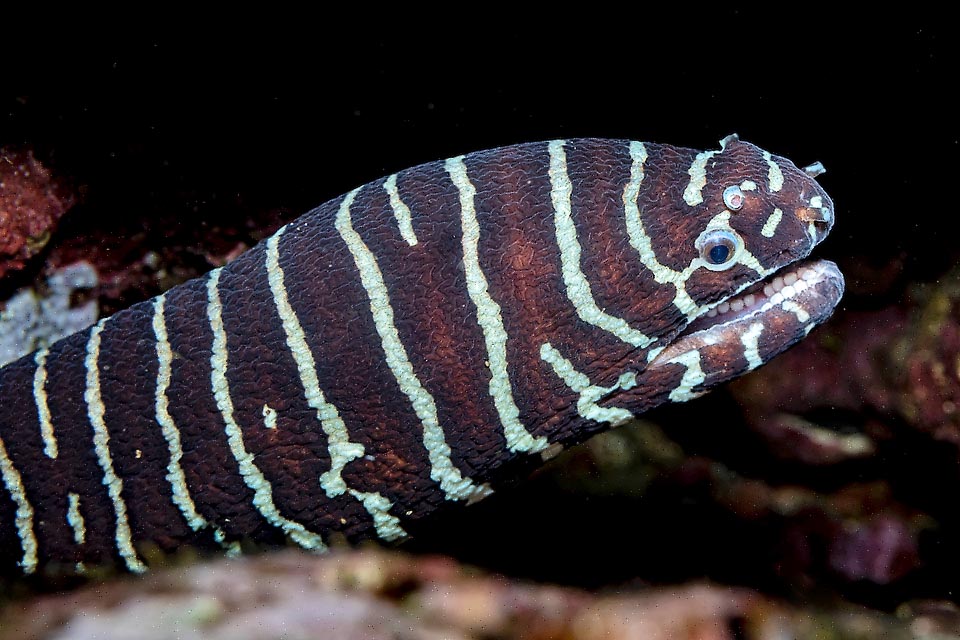
Gymonmuraena zebra is a benthic species but for reproduction the couples reach the surface. Eggs and larva are pelagic and these, growing, have the shape of a transparent willow leaf and are called leptocephali. They can roll up in a cylinder to escape the predators and go wandering for months transforming in fishes in far away lands © Allison & Carlos Estape
However, probably considering the vast diffusion and the absence of data concerning the trend of the populations, in 2019 Gymnomuraena zebra has been placed as “Least Concern”, that is not in danger, in the IUCN Red List of the endangered species.
Synonyms
Echidna zebra Shaw, 1797; Gymnomuraena fasciata Kaup, 1856; Gymnothorax zebra Shaw, 1797; Muraena molendinaris Bennett, 1833; Muraena zebra Shaw, 1797; Poecilophis zebra Shaw, 1797.
→ For general information about FISH please click here.
→ For general information about BONY FISH please click here
→ For general information about CARTILAGINOUS FISH please click here.
→ To appreciate the BIODIVERSITY of BONY FISH please click here.
→ To appreciate the BIODIVERSITY of CARTILAGINOUS FISH please click here.
